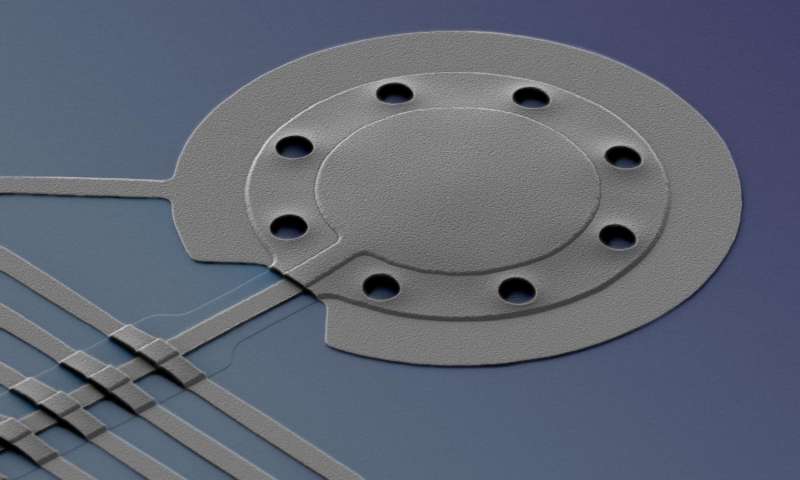
This microscopic vibrating drum was, at one point, colder than anything found in nature. Credit: Teufel/NIST
Nothing can be chilled below absolute zero ( −273.15°C) because at this temperature all molecular motion stops completely. Per Heisenberg’s uncertainty principle the forces of real particle velocities will always be above zero. It’s a fundamental limit that can’t seem to be broken. That’s fine just fine — what bothers scientists, however, are other limits that keep them from cooling things near absolute zero.
For decades, researchers have used lasers to cool down atoms very close to absolute zero. However, when you try to cool close to zero something macroscopically, like a power cable or even a coin, you get hit by a brick wall — a ‘quantum limit’ that keeps mechanical objects from getting too cold.
Physicists from the National Institute of Standards and Technology (NIST) weren’t sure that this is a fundamental limit and good thing they experimented because their findings suggest macroscopic objects can be cooled more than previously thought possible.
[ALSO SEE] The minimum and maximum temperatures
Using lasers, the NIST team cooled an aluminum drum to 360 microKelvin or 10,000 times colder than the vacuum of space. The tiny vibrating membrane is 20 micrometers in diameter and 100 nanometers thick. It’s the coldest thing we’ve ever seen that’s larger than a few atoms across.
“The colder you can get the drum, the better it is for any application,” said NIST physicist John Teufel, who led the experiment. “Sensors would become more sensitive. You can store information longer. If you were using it in a quantum computer, then you would compute without distortion, and you would actually get the answer you want.”
“The results were a complete surprise to experts in the field,” Teufel’s group leader and co-author José Aumentado said. “It’s a very elegant experiment that will certainly have a lot of impact.”
Everyone’s familiar with lasers but firing lasers to cool stuff? It sounds counter-intuitive because we all know lasers warm targets — but that’s if you fire all of the light. The kind of lasers used for cooling fire at a specific angle and frequency. Typically multiple lasers are used. As a result of this clever tweaking photons actually end up snatching energy from its target instead of releasing it, and it’s all done by literally pushing the atoms.
Confused? It gets elementary once you understand or remember what temperature actually is — the motion of atoms. That’s it. When we feel warm, atoms are whizzing past us faster. When it’s cold outside, the molecules in the air are moving slower. So, what scientists do when they fire lasers is they push these atoms in the opposite direction of their motion. As the photon gets absorbed by the target atom(s), the photon’s momentum is transferred.
Laser pulses, however, like any light, fires in discrete packets of energy called quanta. This means there’s a gap between packets which gives atoms the time to resume motion. That’s how light works and quantum mechanics seems to suggest there’s an upper limit. Previously, NIST researchers used sideband-cooling to limit the thermal motion of a microscopic aluminum membrane that vibrates like a drumhead to one-third the amount of its quantum motion.
The NIST researchers took laser cooling a step further by using ‘squeezed light’ — light that’s more organized in one direction than any other. By squeezing light, the noise, or unwanted fluctuations, is moved from a useful property of the light to another aspect that doesn’t affect the experiment. The NIST team used a special circuit to generate microwave photons that were purified or stripped of intensity fluctuations, which reduced inadvertent heating of the drum.
“Noise gives random kicks or heating to the thing you’re trying to cool,” Teufel said. “We are squeezing the light at a ‘magic’ level—in a very specific direction and amount—to make perfectly correlated photons with more stable intensity. These photons are both fragile and powerful.”
The NIST paper published in Nature seems to suggest squeezed light removes the generally accepted cooling limit. Teufel says their proven technique can be refined to make things even cooler — possible even to exactly absolute zero. And that, ladies and gentlemen, is the coolest thing you’ll hear today.
“In principle if you had perfect squeezed light you could do perfect cooling,” he told the Washington Post. “No matter what we’re doing next with this research, this is now something we can keep in our bag of tricks to let us always start with a colder and quieter and better device that will help with whatever science we’re trying to do.”









